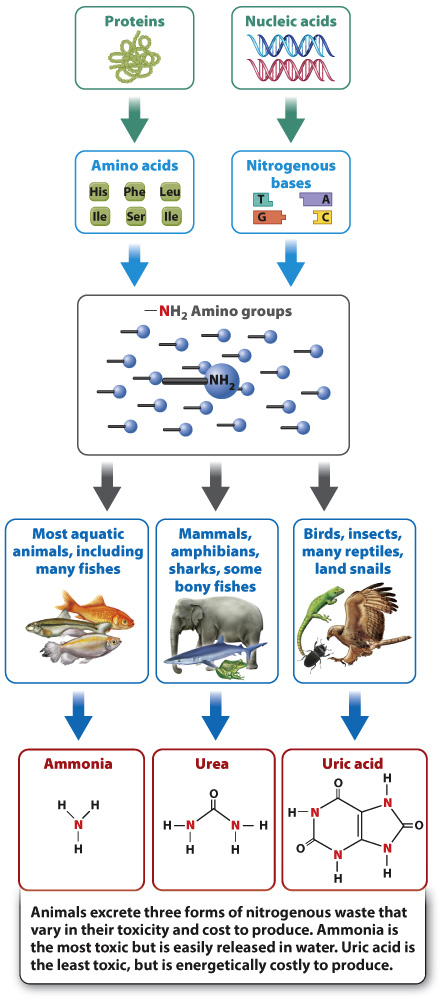The excretion of nitrogenous wastes is linked to an animal’s habitat and evolutionary history.
When proteins and nucleic acids are broken down, one of the by-

Some organisms, such as fish, are able to excrete ammonia directly into the surrounding water, primarily through their gills. As a result, ammonia does not accumulate to toxic levels. This process is not energetically expensive, but it requires high volumes of water in the surrounding environment to dilute the highly toxic ammonia.
When animals moved from water to land, they faced the challenge of how to eliminate waste. No longer could they rely on simple diffusion of ammonia into the surrounding water. Instead, they evolved biochemical pathways to convert ammonia to less toxic forms. One of these forms is urea (Fig. 41.6). Because urea is less toxic than ammonia, it can be stored in a fairly concentrated form before being excreted. Mammals (including humans), many amphibians, sharks, and some bony fish excrete nitrogenous waste in the form of urea. In mammals, urea is produced in the liver and is then carried by the blood to the kidneys, from which it is eliminated. Urea is less toxic than ammonia but requires energy to produce and water to eliminate.
Ammonia can also be converted into uric acid (Fig. 41.6). Uric acid is the least toxic of the three forms of nitrogenous waste, so animals can store it at a higher concentration than urea. Birds and many reptiles, arthropods (including insects), and land snails excrete nitrogenous waste in the form of uric acid. These groups evolved the ability to convert ammonia to uric acid independently of one another as an adaptation to living on land, providing a good example of convergent evolution (Chapter 23). Uric acid precipitates from solution and forms a semisolid paste (familiar as bird droppings). Because uric acid is not dissolved in water, it does not exert osmotic pressure and is eliminated with minimal water loss. By limiting water loss, many reptiles and insects are able to live in extremely hot and dry environments. However, uric acid is energetically expensive to produce.
Many amphibians, like frogs, excrete ammonia early in their development, when they live in water, but then excrete urea when they move onto land after metamorphosis. Alligators and turtles also adjust what they excrete: ammonia when in the water and uric acid when on land.
Ammonia, urea, and uric acid are the three major forms of nitrogenous wastes. However, they are not the only forms. Animals excrete nitrogen as trimethylamine oxide, creatine, creatinine, and even amino acids. The form of nitrogenous waste that an animal excretes is ultimately linked to its environment and evolutionary history.
Quick Check 3 Why do mammals convert ammonia to urea rather than simply excreting it, as fish do?
Quick Check 3 Answer
Ammonia excreted by fish is rapidly diluted to nontoxic levels in the surrounding water. Mammals convert ammonia to urea, which is much less toxic than ammonia and therefore can be concentrated and stored before being eliminated.